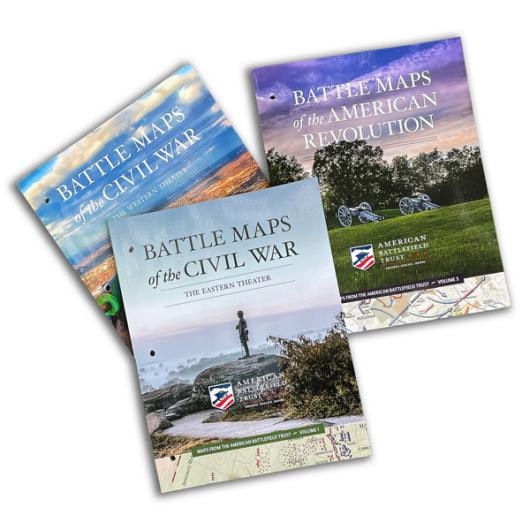American Battlefield Trust’s Accomplishments
The American Battlefield Trust, through its divisions and predecessor organizations, has spent more than 30 years at the forefront of the fight to protect some of the most important landscapes in this nation’s history and to help educate the public about the formative events of the country’s first century.
Our accomplishments are legion, chief among them saving more than 50,000 acres in 24 states. This land stretches chronologically from the Lexington Green to Appomattox Court House, and geographically from Minnesota to New Mexico. Our legacy stretches from the 1813 Battle of Sacket’s Harbor on Lake Ontario, near the Canadian border, to the 1865 engagement at Palmetto Ranch, near the Mexican border and the Gulf of Mexico. All told, since 1999 we have raised more than $350 million toward battlefield preservation from public and private sources, including $52.5 million as part of Campaign 150: Our Time, Our Legacy, during the Civil War sesquicentennial commemoration.
Individual achievements reflect the three aspects of our missionIndividual achievements reflect the three aspects of our mission articulated in the American Battlefield Trust motto: Preserve. Educate. Inspire.
Preserve.
The permanent protection of battlefield land through outright purchase or conservation easement has always been and will always remain the heart of our mission. In this vein, we have preserved impressive amounts of land at many sites across the nation. For example, we have cumulatively saved 1,945 acres at the sites of the Seven Days’ Battles around Richmond in the summer of 1862. This includes 678 acres at Glendale, where, prior to our efforts, the National Park Service owned a single acre at the national cemetery — a process that one historian termed preserving a “major battlefield virtually from scratch.” Similarly, our partnership with the South Carolina Battleground Preservation Trust on the Liberty Trail began with an effort to protect 1,037 acres at six locations, the largest private preservation effort ever undertaken for Revolutionary War sites. At Shiloh, the 504-acre project we announced on the battle’s 150th anniversary represented the largest addition to that national park since its creation in 1895.
But we have consistently focused on the quality of land, not merely the quantity. In many instances, we have sought out critical properties that represent “missing pieces” of battlefields where other areas are already set aside. In 2015, we purchased and subsequently restored the Epicenter, a 44-acre property near Antietam National Battlefield that was among the bloodiest spots during the bloodiest day in American history. After a decades-long controversy, we were able to reach an agreement with the Institute for Advanced Study that allowed them to construct needed faculty housing, while still protecting forever the site of George Washington’s pivotal personal charge at the January 1777 Battle of Princeton. And while our roughly 1,400 protected acres we have acquired at Brandy Station are a so substantial they may soon become a new Virginia state park, it was our long-sought acquisition of the 56-acre parcel at the crest of Fleetwood Hill and removal of its obtrusive McMansion that represents the crowning achievement in that decades-long campaign.
Through the protection of some sites, we are able to tell important stories that all Americans should know. Like Morris Island, S.C., site of the doomed charge of the 54th Massachusetts Infantry, the pioneering African American regiment depicted in the Academy Award-winning film Glory. Or the Slaughter Pen Farm, the only place on the battlefield at Fredericksburg, Va., where the Union Army gained any type of foothold in the otherwise-lopsided Confederate victory and five men earned the Medal of Honor. Or the site of Parker’s Revenge on April 19, 1775, the very first day of the Revolutionary War. There, Minute Men who had been bested on the Lexington Green that morning ambushed the British as they returned to Boston, turning what had been an orderly retreat into a rout.
Nor does our work end once the deed to a historic property is in hand. Often, we must engage in large-scale landscape restoration efforts on a site to convey its significance to visitors. This process may involve removing modern structures, approximating wartime tree lines, replanting orchards and replacing fences.
In terms of physical size, our largest-scale restoration project to date has centered on our 407-acre holdings in the vicinity of the Breakthrough at Petersburg. This massive, multiphase effort removed 160 acres of non-historic timber, using the revenue to pay for other remediation projects — including removal of a home, three barns, four grain silos and assorted buildings from a hog farm.
At Franklin, Tenn., local preservationists and the Trust have partnered to reclaim important parts of the battlefield that had been destroyed over many decades by suburban development. Once a cautionary tale for historic communities, Franklin has spent the last 15 years rolling back the concrete one small parcel at a time, creating a true “destination” battlefield.
In recent years, no example of battlefield restoration has been as visible as the Trust’s at Lee’s Headquarters in Gettysburg. The Trust completed a $5.5 million national fundraising campaign to buy the commercial property, including the Mary Thompson House, which served as the Confederate army’s combat command center. Then, to return the headquarters to its wartime appearance, the Trust removed 10 modern structures — most notably a hotel and its parking lot —as well as several postwar additions to the Thompson House.
Educate.
Even a perfectly preserved battlefield will lose its meaning if, generations hence, Americans do not study and appreciate the events that took place there. Thus, educational outreach is an integral pillar of our mission.
We believe that a protected battlefield can become an unparalleled outdoor classroom. This transformation is particularly literal at the Cool Spring battlefield near Berryville, Va. After purchasing an important section of the battlefield, the Trust transferred it to Shenandoah University, which now operates it as the university’s River Campus. In working to transition the ground away from its past as a golf course, students in a variety of disciplines have gained practical experience in studying this living laboratory.
To transform battlefields into educational tools, the Trust enlists a variety of interpretation formats — from traditional signs and walking trails to our GPS-enabled, multimedia Battle App guides for select sites. Other digital products that can be used anywhere in the world include our animated maps and annotated 360-degree panoramas. Our website is one of the greatest resources for American military history on the Internet, while our award-winning membership magazine, Hallowed Ground, features articles by leading historians as well as updates on preservation activities.
Because of the incredible power that an inspirational teacher can have on thousands of children over the course of a career, the Trust is dedicated to providing high quality educator resources at little to no cost. Our commitment is such that we received the 2018 Friend of History Award from the Organization of American Historians, that group’s top honor for those working outside of the traditional academic sphere.
Each summer, educators are welcomed to our Teacher Institute, where they earn continuing-education credits and trade expertise on innovative classroom techniques. The event is free, and scholarships are available to cover participants’ travel and lodging costs. Throughout the year, educators can browse our catalog of lesson plans, communicate with one another through the Teachers Regiment online community and seek advice from our award-winning Teacher in Residence.
Perhaps our most popular classroom program, however, is the History Field Trip Grant Program, which provides grants to help pay for classes to visit battlefields and other historic sites, because we know that walking in the footsteps of heroes is the best way to understand and appreciate history. In less than four academic years — and without diverting any money donated toward land-acquisition efforts — the History Field Trip Grant Program has enabled educators to lead students from 125 school districts in 21 states on educational visits to 74 sites.
Inspire.
The battlefield preservation community is robust and vibrant, filled with a shared sense of purpose and camaraderie. Spots on particularly desirable tours at our Annual Conference disappear at a speed more typically associated with concert tickets. Our members know that the Trust is an outstanding steward of their donation dollars and are eager to leave a tangible legacy in the form of a physical landscape.
The Trust “family” extends far beyond major or longtime donors. Our Generations program consists of carefully planned events designed to help adults share their passion for history with young people — grandchildren, nieces, neighbors, friends. With nearly 400,000 followers, our online community is one of the largest in the preservation world.
We also strive to share some of the less obvious benefits of battlefield preservation with people and officials who might not otherwise be advocates for our cause. We eagerly showcase how heritage tourism can be an economic engine for surrounding communities, how it increases residents’ quality of life, and how it benefits the environment.
Undaunted advocates for historic landscapes, when necessary the Trust engages in campaigns to stop the threat of inappropriate development, alongside local and national partners. We have twice spearheaded coalitions that defeated proposals to build a casino in Gettysburg and led the charge that ultimately resulted in Walmart voluntarily moving its proposed store away from the Wilderness battlefield. In Spotsylvania County, Va., controversy surrounding a plan that would have destroyed the First Day at Chancellorsville battlefield — thanks to tireless grassroots campaigning by preservationists — resulted in a major shakeup of the Board of Supervisors, leading to a sweeping series of conservation victories.









